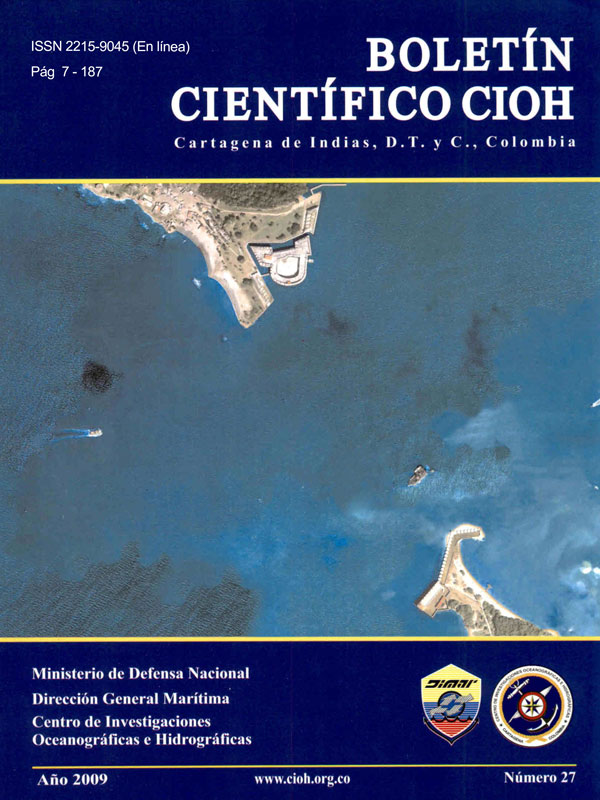Identifying spatial and temporal patterns of Lobster abundances in the San Andres Archipelago: an experience of co-management
DOI:
https://doi.org/10.26640/22159045.208Keywords:
Lobster abundance, Panulirus argus, San Andres archipelago, spiny lobster, fishers involvementAbstract
The bony lobster is the main fishing activity in the San Andres Archipelago, however detailed knowledge of its spatial and temporal distribution patterns remains unknown. This paper presents an experience of co-management in order to locate main fishing areas s well as the lobster abundance trends in a highly exploited region with minimal previous scientific information. Atotal of 20,870 geographical locations of trap line settings were obtained from 26 captain logs over a twelve- year period. Positions of fishing trap lines were plotted using a geographic information system to generate thematic maps identifying fishing areas on a monthly and yearly basis to determine lobster abundance. The section of the Nicaraguan shelf which belongs to Colombia (Green Moon) was the region supporting the most fishing effort (68.3% of trap locations) and sections of Quitasueño shelf accounted for 14% of the fishing ground. Several, isolated and uncharted locations were identified which expanded the range of known lobster habitat with high lobster densities. On average 1,750 km2 (±SD=1,025) were monthly caught, with each boat covering 179 km2*month-1 (±SD= 74). Traps were moved from one area to another depending on the month, but Green Moon is fished year round. The largest fishing areas were observed in August, coinciding with the peak in lobster reproduction. Annual fishing areas included 2,841 km2*year-1 (±SD=585). Out of the 6,227 km2 of the overall fishing area, only 6% (1,060 km2) were considered a high density of lobster zone. Lobster density decreased from 14.1 lobster per 'lingada'-1 in 1994 to 2.9 lobster per 'lingada' -1 in 2005. Lingada is the common word utilized by fishermen to estimate the number of traps in a line and it is understood as a set with 25 traps, with a line having usually four lingadas (100 traps), The importance of bringing fishermen and managers together to share the knowledge each group possesses and to be able to handle a valuable fishing resource in a sustainable way has been pointed out.Downloads
References
[2] Prada MC, Castro ER, Pomare C. Diagnóstico de la pesquería de langosta espinosa (Panulirus argus) y del caracol de pala (Strombus gigas) en el Archipiélago de San Andrés y Providencia. Informe final orden de servicios 9/2004, proyecto: Programa de Ordenación, manejo y conservación de los recursos pesqueros en la Reserva de Biósfera Seaflower. Secretaria de Pesca y Agricultura, informe Técnico interno. San Andrés Isla. 2004; 47 p.
[3] Medina J, Rojas M, Gallo J. Aspectos de la dinámica poblacional de la Langosta Espinosa Panulirus argus (Latreille, 1804)en el departamento Archipiélago de San Andrés, Providencia & Santa Catalina (Caribe colombiano). INPA. Boletín Científico 1996; 4:107-124.
[4] Prada MC, Castro ER, Grandas Y, Connolly E. 2004. Effects of divers fishing in the San Andres Archipelago: Consideration towards fisheries management and conservation. Memorias 57ava reunión annual del Instituto de Pesquerías y del Golfo. St. Petersburgh, Florida, USA. 905-916p.
[5] Díaz JM, Barrios LM, Cendales M, Geister J, Parra F, Pinzón J, Vargas B, Zapata F, Díaz-Pulido G, Garzón-Ferreira J, Sánchez JA, Zea S. Áreas Coralinas de Colombia. INVEMAR. Santa Marta. Serie Publicaciones Especiales No 5. 2000 Nov; 75 p.
[6] Heinemann D, Appeldoorn RS, Dahlgreen C, Herrón P, Prada MC, Sanchez JA. Joint Ocean Conservancy–CORALINARapid Ecological Assessment of the Northern Banks of the Archipelago of San Andres and Old Providence. San Andres Island, Colombia. Techcnical Report, unpublished MS. 200 Feb 24; 50 p.
[7] CLME project implementation unit. Overview of the Sub-regional Preliminary Transboundary Diagnostic Analyses for the Caribbean Large Marine Ecosystem and its Adjacent Region, the North Brazil Shelf. Centre for Resource Management and Environmental Studies, University of the West Indies, Cave Hill Campus, Barbados. 46p.
[8] Geister J. Holozäne westindiche korallenriffen: Geomorphologie, oekologie und fazies. Facies 1983; 9:173-284.
[9] Andrade CA, ED Barton. 2000. Eddie development and motion in the Caribbean Sea. J Geo. Res. 105:195-201.
[10] Andrade CA. 2005. La circulación y variabilidad de la cuenca de Colombia en el Mar Caribe, Edición especial del CIOH, DIMAR.
[11] Andrade CA. Las corrientes superficiales en la cuenca de Colombia observadas con boyas de deriva. Revista de la Academia Colombiana de Ciencias Exactas, Físicas y Naturales. 2001; 96:322-335.
[12] González E. Oceanografía física y descriptiva del Archipiélago de San Andrés y Providencia con base en el análisis de los cruceros Océano VI al IX. Boletín Científico CIOH. 1987; 73-100.
[13] Chiquillo M, Ragua J, Rojas M, Rubio E. Evaluación de las pesquerías de la langosta espinosa (Panulirus argus) y el caracol de pala (Strombus gigas) en el archipiélago de San Andrés, Providencia y Santa Catalina. INPA, informe final primera etapa. Bogotá. 1994; 106 p.
[14] Nowlis J, Castro ER, Prada MC, Bent H, Ballesteros C, Wilson H. 2009. Recomendaciones técnicas para el establecimiento de la cuota global de langosta espinosa en la Reserva de Biósfera Seaflower para el 2010. Documento técnico Secretaría de Agricultura y Pesca-CORALINApresentado al Comité Ejecutivo para la Pesca, sin publicar. San Andrés Isla. 8p.
[15] Fish Information and Services. En Honduras langosteros inician la temporada con poco optimismo. 27 de julio, 2009. http://fis.com/fis/worldnews/worldnews.asp?l=s&country=91&special=&monthyear=7-2009&day=1&id=33213&ndb=1&df=1.
[16] Pomeroy R S, Rivera-Guieb R. 2006. Fisher y co-management: a practical handbook. CABI International and International Development Research Centre. ISBN-10: 0-85199-088-6.166
Downloads
Published
Issue
Section
License
Attribution — You must give appropriate credit, provide a link to the license, and indicate if changes were made. You may do so in any reasonable manner, but not in any way that suggests the licensor endorses you or your use.
NonCommercial — You may not use the material for commercial purposes.
NoDerivatives — If you remix, transform, or build upon the material, you may not distribute the modified material.
No additional restrictions — You may not apply legal terms or technological measures that legally restrict others from doing anything the license permits.



